Waiting for the Russian heavy shock drone
Recent armed conflicts have clearly demonstrated the potential of heavy unmanned aerial vehicles. Due to the relatively large take-off mass, such equipment can carry not only reconnaissance equipment, but also a certain range of weapons. Thus, a heavy UAV is capable not only of detecting targets, but also attacking them, which reduces the time spent on the combat mission, and also allows you not to miss the target. However, in our country the heavy sector of unmanned aerial vehicles over the past years has not received the special attention of designers. Back in Soviet times, several designs were created with a take-off weight of more than one ton (Tu-141, Tu-143, Tu-243, etc.), but all of them were intended for reconnaissance and other similar tasks. Creating a UAV with shock capabilities in our country began relatively late, only in the late nineties. Because of this, there are still no ready-made systems of this class in service with our army. Over the past years, several certainly interesting projects were created, but none of them has yet reached mass production.
"Skat"
In 2007, at the MAKS air show, the MiG Corporation presented its new project. An interesting feature of this project was the fact that before the presentation there was almost no information about it, but, nevertheless, a full-scale model of the future was immediately shown at the salon in Zhukovsky drone. Due to such a “surprise”, the Skat project immediately attracted attention and became the subject of a lot of discussion. In general, such a reaction was not surprising: the Skat became one of the first known domestic projects of a strike UAV, and its relatively large take-off mass markedly distinguished it from the total mass of new domestic developments. In addition, Skat became the first representative of its class to reach the stage of assembling a life-size model.
The appearance of the drone "Skat" resembled the fish of the same name: it was proposed to build an aircraft according to the scheme of a flying wing. In addition, well-known techniques for reducing radar visibility were clearly visible in the design of the structure. Thus, the wing tips are parallel to its leading edge, and the rear sections of the vehicle are also made in the same way. Above the middle part of the wing "Skat" had a fuselage of characteristic shape, smoothly mated with bearing surfaces. Vertical plumage was not provided. As can be seen from the photographic materials of the Ramp, the control was to be carried out using four elevons located on the consoles and on the center section. At the same time, certain issues immediately caused yaw control: in the absence of a rudder and a single-engine scheme, the UAV required to somehow solve this problem. There is a version of the single deflection of internal elevons for yaw control.
The layout presented at the MAKS-2007 exhibition had the following dimensions: the wingspan of the 11,5 meter, the length of the 10,25 and the parking height of the 2,7 m. Relative to the mass of the Skat, it is only known that its maximum take-off weight should be approximately ten tons. With such parameters, the Skat had quite good calculated flight data. With a maximum speed of up to 800 km / h, it could climb to an altitude of up to 12 thousands of meters and travel in flight up to 4000 kilometers. Such flight data was planned to be provided using a RD-5000B turbojet engine with a 5040 kgf thrust. This TRD was created on the basis of the RD-93 engine, but initially it is completed with a special flat nozzle, reducing the visibility of the aircraft in the infrared range. The engine air intake was located in the nose of the fuselage and was an unregulated intake device.
Inside the fuselage of the characteristic form "Skat" had two cargo compartments of 4,4x0,75x0,65 meters in size. With such dimensions in the shipment compartments it was possible to hang guided missiles of various types, as well as adjustable bombs. In a number of sources it was mentioned that the Skate airborne equipment was planned to be adapted only for ground attack, which would reduce the possible range of guided weapons, reducing it to air-to-surface types. The total mass of the load of the "Stingray" should be approximately equal to two tons. During the presentation, at the MAKS-2007 cabin, near the Skat, there were X-31 missiles and KAB-500 adjustable bombs.
The composition of the onboard equipment implied by the project was not disclosed. Based on information about other projects of this class, it is possible to draw conclusions about the presence of a complex of navigation and sighting equipment, as well as some possibilities for autonomous actions. However, official data on the Skat electronic equipment have not been received for five years.
After the first demonstration, the Scat project was mentioned several times in official sources, but it was subsequently closed. At present, as mentioned in some sources, the developments of the MiG corporation under the Skat project are being used by the Sukhoi company in the development of a promising drone drone.
"Breakthrough"
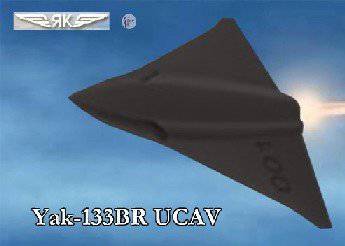 The Yakovlev Breakthrough program is still one of the most mysterious in stories modern Russian aircraft industry. All information about it is limited to a few paragraphs of text and a table with approximate characteristics. Even the approximate dates of commencement of work in this direction are not completely clear.
The Yakovlev Breakthrough program is still one of the most mysterious in stories modern Russian aircraft industry. All information about it is limited to a few paragraphs of text and a table with approximate characteristics. Even the approximate dates of commencement of work in this direction are not completely clear.Presumably in the late nineties in the Design Bureau. Yakovlev began to consider the possibility of creating a multi-purpose unmanned aerial vehicle with extensive use of the developments of the Yak-130 project. There is evidence of a positive opinion regarding the possibility of using on the drone a significant part of the onboard radio-electronic equipment of the original training aircraft. It was assumed that such an approach could facilitate the development and production of a new UAV, as well as provide a high degree of unification of the UAVs of the same family. The latter possibility was particularly important, since the Breakthrough program meant the creation of several unmanned aerial vehicles for various purposes - impact, reconnaissance, and radar detection UAVs.
In the middle of the two thousand years, the first details appeared regarding the appearance of the Proriv family drones. Thus, the shock version had to be somewhat similar to the MiG Skat, a flying wing with one engine and internal cargo compartments for armament. At the same time, in one of the available “Breakthrough-U” drawings (this is how the shock drone is marked), a triangular wing is visible, and two air intakes are visible on the upper surface of the wing. In other images, “Breakthrough-U”, also referred to as Yak-133BR, has hull lines and air intake placement similar to the “Skat”. With a take-off weight of about ten tons, the impact version of the Breakthrough UAV was supposed to have an estimated practical ceiling of about 15-16 kilometers and a maximum speed of 1050-1100 km / h. According to various estimates, the payload of such a drone should have been two or three tons. Obviously, the range of weapons would be the same as that of the Skat: guided missiles and bombs for attacking ground targets, suitable for weight and size parameters.
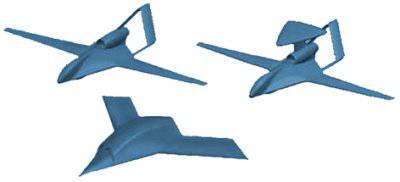 The image of the three-dimensional model of the Proryv-U, similar to the Scat UAV, also shows two other aircraft, the reconnaissance Proryv-R and Proryv-RLD, intended for radar detection. Their gliders almost do not differ from each other. At the same time, the reconnaissance Breakthroughs are significantly different from the strike version. Versions "P" and "RLD" on the images instead of the swept wing of medium elongation have a wing of small sweep, large elongation and small narrowing. Thus, losing shock drone at maximum speed, reconnaissance vehicles can have higher characteristics of takeoff and landing, as well as a long flight at high altitudes. In addition to the characteristic wing, Proryv-R and Proryv-RLD are equipped with tail feathers of the original design. Two comparatively thin beams, on which two surfaces are fixed, depart from the fuselage of the UAVs. Obviously, the rudders placed on them can be used for pitch and yaw control. Finally, the powerplant of both reconnaissance UAVs of the Breakthrough program is located in the nacelle at the rear of the fuselage. The most significant difference in the appearance of the "Proryva-R" and "Proryva-RLD" is a large radome onboard the radar on the latter.
The image of the three-dimensional model of the Proryv-U, similar to the Scat UAV, also shows two other aircraft, the reconnaissance Proryv-R and Proryv-RLD, intended for radar detection. Their gliders almost do not differ from each other. At the same time, the reconnaissance Breakthroughs are significantly different from the strike version. Versions "P" and "RLD" on the images instead of the swept wing of medium elongation have a wing of small sweep, large elongation and small narrowing. Thus, losing shock drone at maximum speed, reconnaissance vehicles can have higher characteristics of takeoff and landing, as well as a long flight at high altitudes. In addition to the characteristic wing, Proryv-R and Proryv-RLD are equipped with tail feathers of the original design. Two comparatively thin beams, on which two surfaces are fixed, depart from the fuselage of the UAVs. Obviously, the rudders placed on them can be used for pitch and yaw control. Finally, the powerplant of both reconnaissance UAVs of the Breakthrough program is located in the nacelle at the rear of the fuselage. The most significant difference in the appearance of the "Proryva-R" and "Proryva-RLD" is a large radome onboard the radar on the latter.According to reports, the Prorivy reconnaissance drones were supposed to have a takeoff weight of about ten tons, but the Proryv-R was slightly lighter. Simultaneously, the mass of the target equipment was reduced to 1000-1200 kilogram. Compared with the shock option changed flight characteristics. For example, the maximum speed of the scouts fell to 750 kilometers per hour. At the same time, Proryv-R, according to calculations, could rise to a height of about 20 kilometers and be in the air for at least 18-20 hours. Breakthrough RLD, in turn, due to slightly deteriorated aerodynamics — it was influenced by a large radome antenna over the fuselage — had to have a ceiling about 14 kilometers and fly for 16 hours.
Unfortunately, this ends all open information on the Breakthrough program. In the few years since the release of the first data, the OKB Design Bureau. Yakovlev did not publish new details. Probably, the Proriv project of the heavy UAV was closed due to the higher priority of other unmanned programs.
"Dozor-600"
The projects "Skat" and "Breakthrough" belong to the category of UAVs, the take-off weight of which significantly exceeds one ton. All projects of domestic designers in this direction until the end at the design stage. At the same time, another project of a drone drone, which nevertheless reached the prototype testing stage, had much less weight.
Dozor-600 UAV (developed by Transas company), also known as Dozor-3, is much lighter than Skat or Breakthrough. Its maximum take-off weight does not exceed 710-720 kilogram. At the same time, due to the classical aerodynamic layout with a full-fledged fuselage and a straight wing, it has approximately the same dimensions as the Skat: a wingspan of twelve meters and a total length of seven. A place for target equipment is provided in the nose of the Patrol-600, and a stabilized platform for observational equipment is installed in the middle. In the tail of the drone is located propeller group. Its basis is the piston engine Rotax 914, similar to the IAI Heron and the American MQ-1B Predator installed on Israeli.
The 115 horsepower engine allows the Dozor-600 drone to accelerate to a speed on the order of 210-215 km / h or to make long flights at cruising speed in 120-150 km / h. When using additional fuel tanks, this UAV can be airborne for up to 24 hours. Thus, the practical range of flight is approaching the mark of 3700 kilometers.
Based on the characteristics of the UAV "Dozor-600", we can draw conclusions about its purpose. A relatively small take-off weight does not allow him to carry any serious weapons, which limits the range of tasks to be solved only by intelligence. Nevertheless, a number of sources mention the possibility of installing various weapons on Dozor-600, the total mass of which does not exceed 120-150 kilograms. Because of this, the nomenclature of weapons permissible to use is limited only to certain types of guided missiles, in particular anti-tank missiles. It is noteworthy that when using the Dozor-600 anti-tank guided missiles, it largely becomes similar to the American MQ-1B Predator, both in terms of its technical characteristics and composition of its weapons.
However, it is too early to talk about the combat prospects of the Dozor-600 drone. The fact is that the recent successes of this project relate to the 2010 year. In July, the 2009 began flight tests of a large-scale prototype. A bit later, the model of the drone was demonstrated at the MAKS-2009 cabin. Shortly after participating in the exhibition, new reports on the “Dozor-600” project began to appear less and less. In 2010, the full-size prototype of a drone took off. But in October of the same year, the developer company announced the termination of work on the project. This decision was due to the lack of financial support from potential customers. The Transas company was not able to pay for the Dozor-600 debugging on its own and therefore closed the project. In this case, as stated, most of the work on the project, including the creation of on-board radio-electronic equipment, had already been completed by that time. It is possible that in the future the groundwork for “Patrol-600” will be used in new projects.
"Hunter"
As we see, the development of heavy unmanned aerial vehicles of percussion purposes in our country is going through not the best of times. All projects that seemed promising were either completely closed or their condition raises serious questions. For this reason, high hopes are associated with the new project of the Sukhoi company. Some sources claim that these design works were code-named “Hunter”. At the moment there is very little information on this project. Perhaps the lack of information associated with finding the project in its early stages.
The history of the Sukhoi design bureau project began in 2009, when the leadership of the United Aircraft Corporation announced plans to involve MiG and Sukhoi in the development of a joint project of a heavy UAV. The relevant agreements between aircraft manufacturers were signed in 2011 and 2012. In April last year, the Ministry of Defense approved the technical requirements for a promising percussion UAV, and in the summer there was information about the selection of Sukhoi as the main contractor for the project. At the same time, approximate information appeared on the timing of the work under the Hunter program. It was alleged that the first flight of the device will take place in the 2016 year, and it will go into service in 2020 or later.
Since the research on the “Hunter” theme began only a few months ago, the technical details, as well as the list of military demands, have not yet become public knowledge. There is information about the requirement for a modular architecture of the UAV, which will allow it to quickly change the set of onboard equipment, depending on the current task. In addition, ambiguous, if not fantastic, versions appeared in some unofficial sources. For example, there were suggestions about the development of a drone drone with the ability to perform tasks characteristic of fighters, and the alleged "Hunter" will correspond to the sixth generation of this class of technology. For obvious reasons, it is too early to talk about the veracity of such allegations, because the sixth generation fighter general criteria have not even been formed yet.
***
In general, heavy drone drone in our country can not be called a particularly successful class of technology. The total number of such projects is insignificant, while not one of them has reached mass production and adoption. Thus, any such project will be of increased interest and high hopes will obviously be placed on it. Foreign armies have long and successfully used UAVs capable of carrying weapons, but in our country there is no such equipment yet. As a result, any project of similar designation may be “appointed” as the savior of the Russian unmanned industry.
However, to date, active work is carried out only on one project, which will be embodied in metal and composites only in three years, and will go into service even later. Due to the absence of other active works in this direction, the “Hunter” theme turns out to be the only candidate for the title of the first domestic heavy impact UAV. I would like this project to be completed successfully and in our army a new technique has finally appeared, the effectiveness of which has been proven by foreign analogues.
On the materials of the sites:
http://paralay.com/
http://missiles.ru/
http://bp-la.ru/
http://airwar.ru/
http://uav-dozor.ru/
http://militaryrussia.ru/blog/topic-681.html
http://lenta.ru/
http://gazeta.ru/
http://aviaport.ru/
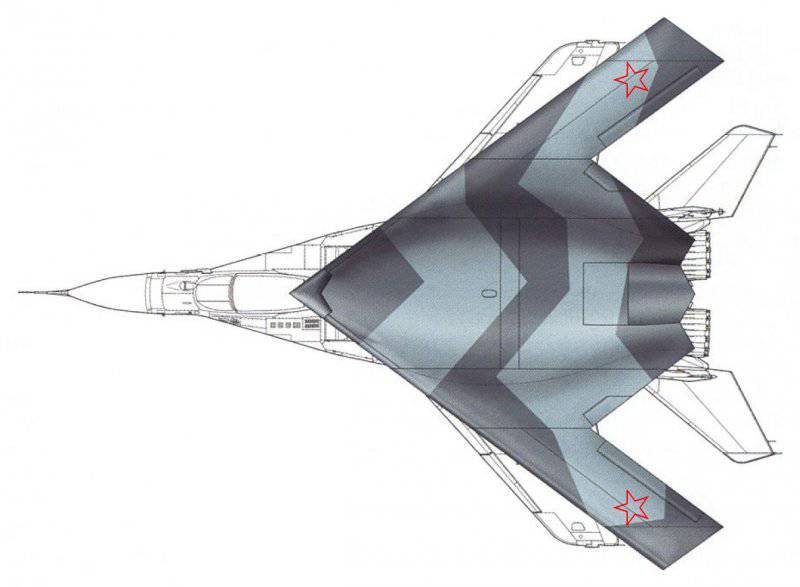
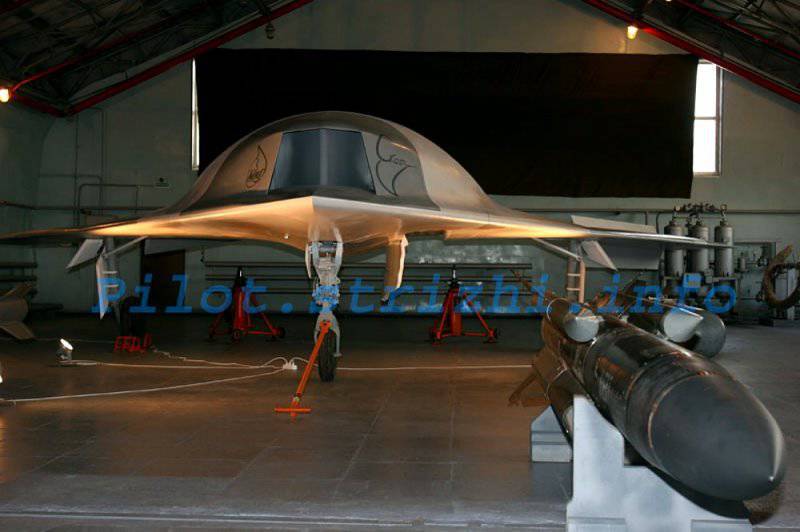
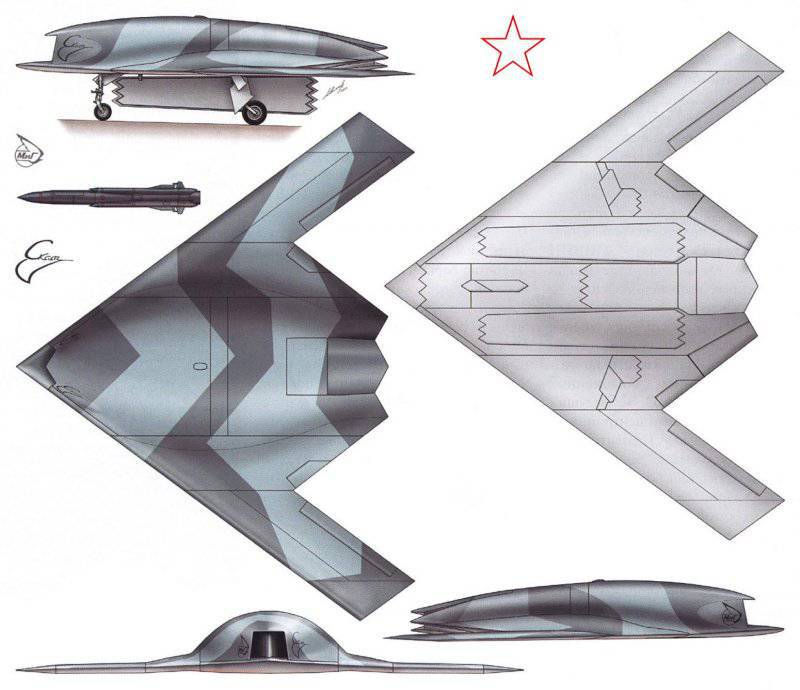
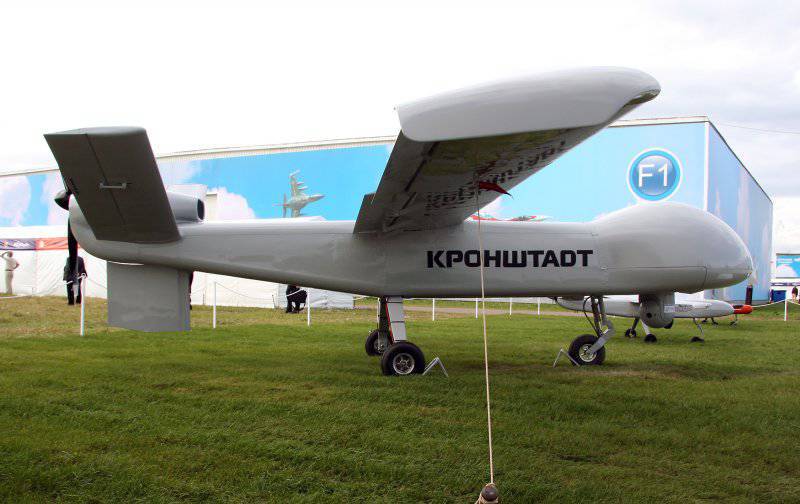
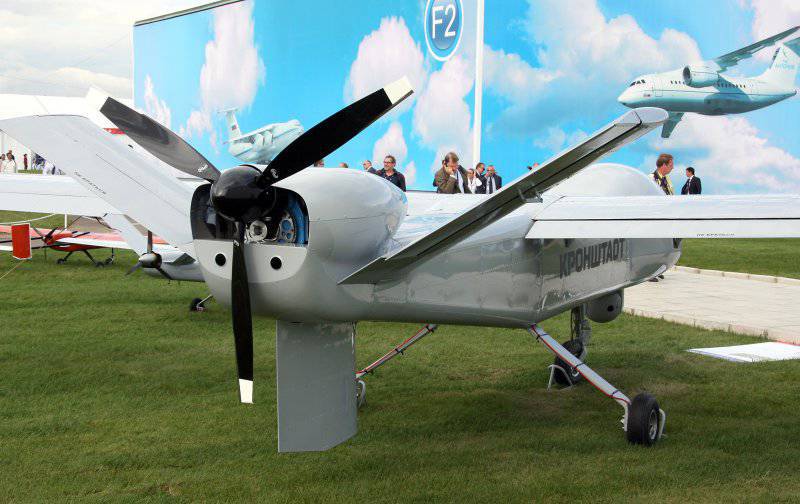
Information